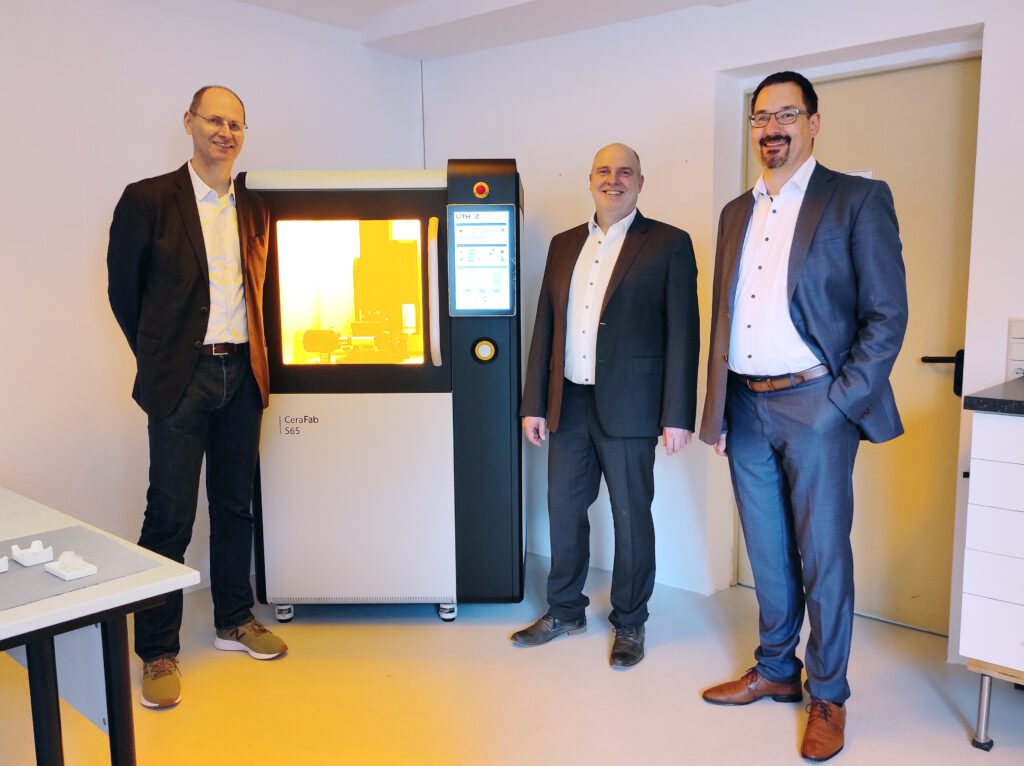- Lithoz GmbH, world leader in ceramic 3D printing, delivered a CeraFab S65 LCM printer to Germany-based WZR ceramic solutions GmbH to manufacture key components for the production of green hydrogen
- The CeraFab S65 printer is part of a partnered DLR (German Aerospace Center) project paving the way to generating green hydrogen via a solar-thermochemical process
- ‘Lithoz is committed to supporting such projects using the industrial standard of LCM technology to make zero emission societies a reality’ – Lithoz CEO Dr. Johannes Homa
14th June 2023: Vienna, Austria. Lithoz GmbH, world market and innovation leader in ceramic 3D printing, has delivered a CeraFab S65 System 3D printer to WZR ceramic solutions GmbH, a leading material development service provider in ceramic 3D printing. As part of the visionary “Redox3D” project to produce green hydrogen in solar tower powerplants through thermochemical processes, the Rheinbach (GER)-based company will use high-precision Lithography-based Ceramic Manufacturing (LCM) technology for the construction of cerium oxide components with highly complex lattice structures, to achieve the much sought-after breakthrough of generating hydrogen entirely independently from fossil energy sources. This solar-thermochemical process, using a 3D-printed ceramic material as the key enabler and sunlight as the primary energy source, is considered one of the key solutions in making zero emission societies a reality.
WZR, who has been working with ceramic 3D printing since 2004, is part of the “Redox3D” project, where they will partner with the DLR (German Aerospace Center) to determine the ideal lattice structure for the optimum solar heat penetration into cerium oxide components. For this important mission, which has received public funding by the German Federal Ministry for Economics and Climate Action (03EE5124A), WZR identified Lithoz’s industry-leading ceramic 3D printing system as a potential key technology to develop the solution, with the CeraFab S65 being their first own printer using DLP technology.
The challenges of this project, which will commence in two phases over a total span of 3 years, are perfectly suited to the innovative capabilities of Lithoz LCM technology. The first phase will test and optimize different 3D printing techniques to precisely control and process the cerium oxide ceramic material, with the key technology then being selected. In the second phase, the optimal structures will be designed, supported by calculations of project partner DLR, and then applied to complete the project. The filigree structure produced must be extremely complex to enable the deepest possible penetration of solar energy into the cerium oxide component, which is crucial to achieving the highest efficiency in the energy generation process.
Thanks to the level of complexity and accuracy achievable via LCM, the high level of intricacy required in the structures can be produced, allowing solar energy to penetrate deeper into the parts and thus enabling a more efficient energy extraction process. The exact reproducibility of these parts is also crucial to the success of the project and is made possible with the LCM technique.
‘Using Lithoz’s powerful 3D printing technology and their proactive partnership approach, we are confident that we will achieve the levels of complexity and intricacy in filigree structures needed to achieve our goals in this project,’ explained Dr. Dieter Nikolay, Managing Partner WZR. ‘Thanks to the speed and high-quality surface finish of this technique, we will once again be able to further drive innovation forward, this time with the production of green hydrogen.’ Dr. Johannes Homa, Lithoz CEO, shared his excitement at being part of ‘such important research, especially because we consider hydrogen generated with renewable energy the number one solution to save our planet from further climate change. Lithoz is committed to supporting such projects using the industrial standard of LCM technology to make zero emission societies a reality!’
The Solar Thermal Redoxchemical Production of Hydrogen Using Cerium Oxide 3D-printed Receiver Modules
- As a ‘receiver module’, the cerium oxide assembly is heated up to 1,400 – 1,500 degrees Celsius (approx. 2500 – 2700 Fahrenheit). The ideal shape lattice design (to be defined between WZR and DLR) will ensure that heat penetrates as deeply as possible into the complex part’s structure, making the process as efficient as possible.
- Within that desired temperature window, cerium oxide releases a fraction of oxygen to the atmosphere. The resulting sesquioxide is still stable in its original phase (meaning no phase change affecting the macro-structure) but it has a higher redox chemical energy level which can now be exploited.
- Therefore, the activated cerium sesquioxide receiver module is moved down inside the tower powerplant and cooled down. Once it reaches a certain temperature, water vapor is introduced.
- In contact with the hot surface, the vapor splits into hydrogen (H2) and oxygen (O2), thermodynamically driven by the diffusion of oxygen into the material bulk to refill the “empty oxygen sites”. H2 remains and enriches the sweeps flux.
- After this relaxation, the receiver component can re-enter the reduction process by heating it up again – the cycle restarts from the beginning. The aim is to achieve a specimen stability of several thousand redox cycles.
- The resulting ‘green’ hydrogen has therefore been exclusively generated by a redoxchemical process only made possible by solar energy and a 3D-printed ceramic key component.
About WZR
WZR is a privately owned company with a strong focus on material development for 3D printing of ceramics. Founded in 1996, the company has a broad experience with ceramics regarding analysis and development tasks. Since 2004, 3D printing is part of WZR’s business with a rapidly increasing contribution to total turnover. Today, all relevant 3D printing methods for ceramics are installed at WZR. In total, over 18 different 3D printers are used to develop ceramic materials and process parameters for industrial customers worldwide.
WZR contact: Dr. Dieter Nikolay +49 2226 1698-10 / d.nikolay@wzr.cc
Lithoz Contact: Alice Elt +43 660 1563231 / aelt@lithoz.com

